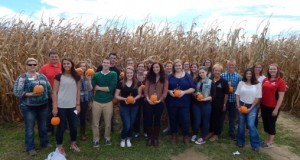When trying something new we’ve not done before, it doesn’t take us long to realize that proficiency requires a dedication to practice and in most cases a good bit of patience. And, you might say that Extension professionals work in teams all the time. It is not often, however, that we work together in national conference planning.

Logo photo courtesy of: ThisisCleveland.com and Larry E. Highbaugh, Jr.
CD professionals have been practicing teamwork and leadership skills around a singular focus since June 2014. That’s when the idea of hosting the annual conference for our professional association, the National Association of Community Development Extension Professionals (a.k.a. NACDEP), was first shared. After learning of our proposal’s success about 18 months later, even more opportunities to practice really kicked. For example, as a team, we have:
- Participated in the past three NACDEP conferences like never before (i.e., ‘What does it take to put this on?’)
- Encouraged colleagues to serve on the national NACDEP board (thank you, Nancy Bowen, treasurer; David Civittolo, president-elect; and Brian Raison, north central representative)
- Served on a variety of prior NACDEP conference sub-committees
- Worked together to identify our conference location (Cleveland) and venue (Renaissance Cleveland Hotel – Downtown)
- Brainstormed and investigated the best things to experience in Cleveland

Exploring a potential conference MLW site: Edgewater Park
With Ohio JCEP’s support, a couple of weeks ago we were able to practice our teamwork and leadership skills in a face-to-face retreat at the conference venue in Cleveland. During this two-day retreat, we:
- Investigated potential conference mobile learning workshop (MLW) ideas in small groups
- Explored the conference hotel and surrounding areas
- Continued our subcommittee work focused on sessions, speakers, sponsorship, publicity, hospitality, MLWs, etc.
This work required our best leadership and teamwork by subcommittee chairs and co-chairs, MLW investigation leaders, and situational leaders too. Even better, we were able to team up with members of the national NACDEP board in this work as they overlapped their annual face-to-face retreat with our conference planning retreat at the 2018 NACDEP Conference venue in Cleveland.
No doubt, there has been much to learn throughout this conference planning process. And when we consciously make the time for it, there is much to learn beyond the ins and outs of how to produce a top-rate NACDEP conference. Every day we have countless opportunities to actively and deliberately practice our skills necessary for working with others. Opportunities to strengthen our skills and build proficiency. The work that lies ahead will require our best teamwork and leadership.
Regardless of the task at hand or the challenge you face, how you go about practicing your skills is up to you.
Let’s ‘suit up!’
Greg Davis is a 2018 NACDEP Conference planning committee co-chair and Extension Assistant Director, Community Development.





 An effective execution plan starts with committing to a series of 15-minute segments on planning and implementing the strategic plan. Franklin Covey’s
An effective execution plan starts with committing to a series of 15-minute segments on planning and implementing the strategic plan. Franklin Covey’s  The LOOK to Clermont program is a series of classroom and practical learning experiences. Here high school students from throughout the county meet monthly to develop and enhance leadership skills while increasing awareness of critical issues within Clermont County. Embedded in this program is a course where students receive college credit through the College Credit Plus program. Juniors receive credit from the University of Cincinnati – Clermont College, while seniors receive credit from The Ohio State University for the COMLDR 3530: Foundations of Personal and Professional Leadership course in the College of Food, Agricultural, and Environmental Sciences.
The LOOK to Clermont program is a series of classroom and practical learning experiences. Here high school students from throughout the county meet monthly to develop and enhance leadership skills while increasing awareness of critical issues within Clermont County. Embedded in this program is a course where students receive college credit through the College Credit Plus program. Juniors receive credit from the University of Cincinnati – Clermont College, while seniors receive credit from The Ohio State University for the COMLDR 3530: Foundations of Personal and Professional Leadership course in the College of Food, Agricultural, and Environmental Sciences. Not only does the LOOK to Clermont program facilitate community development through partnerships with other organizations and local citizens, it unites the Extension program areas in collaboration. Each monthly class has a theme, such as teambuilding, history and agriculture, civic engagement, education, personal finance, safety and justice, community development, or envisioning the future. Depending on the theme for the particular day, the county educators work closely to utilize their personal networks to engage the students in a learning experience that will best benefit them while giving exposure to the individual or group within the county that may be hosting or presenting the class. This allows a Community Development rooted program to nurture the countywide network through Family and Consumer Sciences, 4-H Youth Development, and Agriculture and Natural Resources. Further, the students gain knowledge in a wide array of topics relevant to Clermont County in a short period of time.
Not only does the LOOK to Clermont program facilitate community development through partnerships with other organizations and local citizens, it unites the Extension program areas in collaboration. Each monthly class has a theme, such as teambuilding, history and agriculture, civic engagement, education, personal finance, safety and justice, community development, or envisioning the future. Depending on the theme for the particular day, the county educators work closely to utilize their personal networks to engage the students in a learning experience that will best benefit them while giving exposure to the individual or group within the county that may be hosting or presenting the class. This allows a Community Development rooted program to nurture the countywide network through Family and Consumer Sciences, 4-H Youth Development, and Agriculture and Natural Resources. Further, the students gain knowledge in a wide array of topics relevant to Clermont County in a short period of time. Earlier this month the LOOK to Clermont program held the history and agriculture day. The students met at the Extension office where they discussed the rich history of agriculture in Clermont County with the Agriculture and Natural Resources educator, Gigi Neal. Next, the group toured the county with stops including: Carney’s Feed Mill, Grant’s Farm and Greenhouse, Cornwell Farms, and Shaw Farms. Along the way the students were able to learn about a historic family-based feed milling business, a grain farm and greenhouse in full production, water quality and its importance through a Conservation Innovation Grant Basin and reduction in nutrient run-off.
Earlier this month the LOOK to Clermont program held the history and agriculture day. The students met at the Extension office where they discussed the rich history of agriculture in Clermont County with the Agriculture and Natural Resources educator, Gigi Neal. Next, the group toured the county with stops including: Carney’s Feed Mill, Grant’s Farm and Greenhouse, Cornwell Farms, and Shaw Farms. Along the way the students were able to learn about a historic family-based feed milling business, a grain farm and greenhouse in full production, water quality and its importance through a Conservation Innovation Grant Basin and reduction in nutrient run-off.
 What did the coach do for each of us?
What did the coach do for each of us? Obviously some of our social inventions for working together, resolving conflict, sharing resources and living together have not worked so well. We still settle some of our differences through violence, and there is still racism, prejudice and greed. There are far too many people who live in poverty, lack adequate food, water, education and medical care. However, looking at the facts we can see a decline in all these categories. In the area of hunger we now produce enough food to feed everyone in the world but not everyone has enough food, so we need to invent a new worldwide food distribution system. What we forget is that we invented the current worldwide food system and that
Obviously some of our social inventions for working together, resolving conflict, sharing resources and living together have not worked so well. We still settle some of our differences through violence, and there is still racism, prejudice and greed. There are far too many people who live in poverty, lack adequate food, water, education and medical care. However, looking at the facts we can see a decline in all these categories. In the area of hunger we now produce enough food to feed everyone in the world but not everyone has enough food, so we need to invent a new worldwide food distribution system. What we forget is that we invented the current worldwide food system and that  Let’s leave this place better than we found it. I realized that those nine words communicated many of the ideals that I hope to instill in my daughter: respect, service and commitment to something larger than self. Imagine if each of us began every day with that goal in mind. At work, at school, in our communities, our homes, within our groups and families, if we each made the promise, in any way large or small, to leave this place better than we found it.
Let’s leave this place better than we found it. I realized that those nine words communicated many of the ideals that I hope to instill in my daughter: respect, service and commitment to something larger than self. Imagine if each of us began every day with that goal in mind. At work, at school, in our communities, our homes, within our groups and families, if we each made the promise, in any way large or small, to leave this place better than we found it.
 According to Johnson, to be prepared “The local team needs to understand that every facet of your site is quantitatively ranked and each industry, each project will rank you differently.” In other words, the local team needs to convey the unique things they have to offer each individual prospect and be able to prove it. Corporations are obsessed with “risk avoidance” which means the local team must remove any mystery or perceptions of risk.
According to Johnson, to be prepared “The local team needs to understand that every facet of your site is quantitatively ranked and each industry, each project will rank you differently.” In other words, the local team needs to convey the unique things they have to offer each individual prospect and be able to prove it. Corporations are obsessed with “risk avoidance” which means the local team must remove any mystery or perceptions of risk.